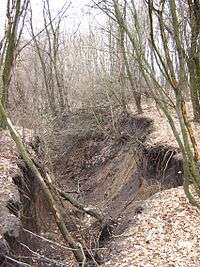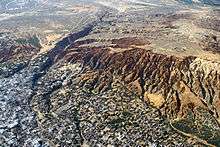Gully
A gully is a landform created by running water, eroding sharply into soil, typically on a hillside. Gullies resemble large ditches or small valleys, but are metres to tens of metres in depth and width. When the gully formation is in process, the water flow rate can be substantial, causing a significant deep cutting action into soil.


Etymology
The earliest known usage of the term is from 1657. It originates from the French word goulet, a diminutive form of goule which means throat. It is possible that the term was derived from a type of knife at the time, a gully-knife, because hills that have gullies look as if they are cut open with a sharp knife.
Formation and consequences
Gully erosion is the process by which gullies are formed. Hillsides are more prone to gully erosion when they are cleared of vegetation, through deforestation, over-grazing or other means. The eroded soil is easily carried by the flowing water after being dislodged from the ground, normally when rainfall falls during short, intense storms such as during thunderstorms.
A gully may grow in length by means of headward (i.e. upstream) erosion at a knick point. This erosion can result from interflow as well as surface runoff.
Gullies reduce the productivity of farmland where they incise into the land, and produce sediment that may clog downstream waterbodies. Because of this, much effort is invested into the study of gullies within the scope of geomorphology, in the prevention of gully erosion, and in restoration of gullied landscapes. The total soil loss from gully formation and subsequent downstream river sedimentation can be sizeable.
Artificial gullies
Gullies can be formed or enlarged by a number of human activities.
Artificial gullies are formed during hydraulic mining when jets or streams of water are projected onto soft alluvial deposits to extract gold or tin ore. The remains of such mining methods are very visible landform features in old goldfields such as in California and northern Spain. The badlands at Las Medulas for example, were created during the Roman period by hushing or hydraulic mining of the gold-rich alluvium with water supplied by numerous aqueducts tapping nearby rivers. Each aqueduct produced large gullies below by erosion of the soft deposits. The effluvium was carefully washed with smaller streams of water to extract the nuggets and gold dust.
On Mars
Gullies are widespread at mid- to high latitudes on the surface of Mars, and are some of the youngest features observed on that planet, probably forming within the last few 100,000 years. There, they are one of the best lines of evidence for the presence of liquid water on Mars in the recent geological past, probably resulting from the slight melting of snowpacks on the surface[1] or ice in the shallow subsurface[2] on the warmest days of the Martian year. Flow as springs from deeper seated liquid water aquifers in the deeper subsurface is also a possible explanation for the formation of some Martian gullies.[3]
Gallery
_1.jpg) A gully in Saratov Oblast, Russia.
A gully in Saratov Oblast, Russia._3.jpg) Inside the gully (to the left) in Saratov Oblast, Russia.
Inside the gully (to the left) in Saratov Oblast, Russia.- Voçoroca (Portuguese for gully) in Avaré, Brasil
See also
- Arroyo (creek) – A dry creek or stream bed with flow after rain
- Badlands – A type of dry terrain where softer sedimentary rocks and clay-rich soils have been extensively eroded
- Canyon – Deep ravine between cliffs
- Coulee – Type of valley or drainage zone
- Couloir – a narrow gully with a steep gradient in a mountainous terrain
- Dale (landform) – Open valley
- Draw (terrain) – Terrain feature formed by two parallel ridges or spurs with low ground in between
- Gulch – Deep V-shaped valley formed by erosion
- Lavaka – A type of gully, formed via groundwater sapping
- Ravine – Small valley, which is often the product of streamcutting erosion
- Rill – a shallow channel cut into soil by erosion from flowing water
- Sunken lane
- Valley – Low area between hills, often with a river running through it
- Wadi – River valley, especially a dry riverbed that contains water only during times of heavy rain
References
- Oxford English Dictionary
- Christensen, PR (2003). "Formation of recent martian gullies through melting of extensive water-rich snow deposits.". Nature 422 (6927): 45–8. doi:10.1038/nature01436. PMID 12594459.
- Costard, F. , Forget, F. , Mangold, N. & Peulvast, J. P. Formation of recent martian debris flows by melting of near-surface ground ice at high obliquity. Science 295, 110–113
- Malin M. C. and Edgett K. S. (2000) Science, 288, 2330–2335.
External links
| Wikimedia Commons has media related to Gully. |